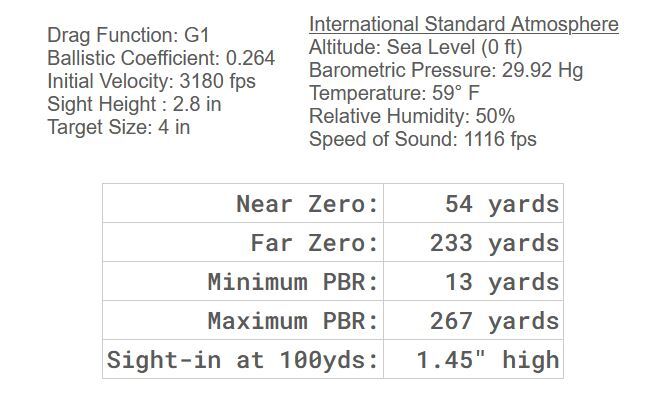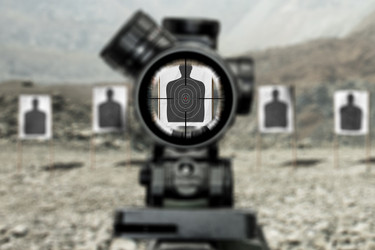How to Use a Maximum Point Blank Range (MPBR) Zero
Posted by Gunbuilders.com on Jul 8th 2025
"Holdovers? What holdovers?!" You ask, as you ring steel anywhere between the bench and a few hundred yards with no effort. What if you could just aim and fire at any target, and always hit near the center? That's what a Maximum Point Blank Range ("MPBR") zero does.
Here's how it works, and how to zero any rifle, optics, and caliber for it.
What is a Maximum Point Blank Range Zero?
The MPBR zero is the maximum distance at which you can directly at the center of a target and still hit within a specific "vital zone" range, with no adjustment to your optics, and with no holdovers being used above or below the reticle.
In other words, an MPBR zero ensures your point of impact matches your point of aim, plus or minus "X" inches, within a certain distance, usually out to a few hundred yards.
What's The Point of This "MPBR" Zero?
The MPBR zero offers immediate target acquisition and accurate points of impacts regardless of how near or far away the target is. There's no need to compensate for bullet drop, and you always get to aim using the center of your reticle while still enjoying a guaranteed hit within the target's center mass.
When To Use The MPBR Zero
The maximum point blank zero is intended for two marksmen: Tactical shooters and hunters. The MPBR zero is ideal for three-gun competitions, tactical engagements, and AR-15 owners. It ensures you'll strike near and far targets without the need to slow down and calculate for bullet drop.
The U.S. Army's standard rifleman zero is, in fact, a type of MPBR Zero: It ensures soldiers can aim at the center of a silhouette target at any distance between 25 and 300 meters and strike it effectively near center mass, with no holdovers.
Hunters also like to employ the MPBR zero because it ensures that, no matter the distance, they'll always strike their game's vital zone to ensure a quick and clean kill simply by aiming with the center of the reticle.
How to Find and Use The MPBR Zero
You can easily calculate the distances at which you need to zero your rifle for the MPBR as long as you know three things:
- Your cartridge's ballistic coefficient
- Your cartridge's muzzle velocity
- Your optic's height over the bore
You can easily obtain your cartridge's BC and velocity by looking at the manufacturer's specifications, which are typically available on their website's product pages. Measuring your optic's height over bore is easily accomplished with a ruler or measuring tape. This can be off by a few fractions of an inch with no meaningful impact on accuracy.
You can also finely tune your MPBR zero based on how large or small of a hitbox you want to use. For example, you can calculate an MPBR zero with a 4" hitbox, meaning all rounds will land 2" above or 2" below the point of aim/
Or you can calculate the zero with a smaller hitbox (like 2", meaning all rounds will land 1" high or low) to increase accuracy across all distances. This will reduce the maximum effective range, but it will also ensure your rounds land within an even smaller area to ensure good effects on the target.
Example: The MPBR Zero for an AR-15
Using this Maximum Point Blank Range Calculator, let's figure out the MPBR Zero for an AR-15 chambering Winchester "White Box" 5.56 NATO (M193) 55-grain ammunition. The optic we're zeroing for is an LPVO with a height over bore of 2.8". We'll use the following real-world data to calculate the rifle's MPBR Zero using a 4" hitbox:
- Ballistic Coefficient: 0.264
- Muzzle Velocity: 3,180 FPS
- Optic Height Over Bore: 2.8"
- MPBR Zero Hitbox: 4"

By feeding the Zero Calculator our data, we find that we can zero at 54 yards or 233 yards, or 1.45" high at 100 yards. Any of these three zeroes will give us our MPBR. Once zeroed, all rounds will land no more than 2" high or low at any distance between 13 and 267 yards.
Say we want an even smaller hitbox of 2". This is a common size for hunters who want to ensure they get accurate lung and heart shots. We can recalculate the zero using the same ballistic coefficient, muzzle velocity, and height over bore accordingly:

Now we find we can zero at 66 yards or 195 yards, or 0.74" high at 100 yards. Now, all rounds will land no more than 1" high or low at any distance between 38 and 220 yards.
The Zero's Limitations
You'll need to chamber the same ammo every time. If, for example, you zero your rifle for 55-grain ammo but then chamber 62- or 77-grain ammo, the MPBR zero will not work properly. Your rounds will likely land outside of your hitbox.
Even if you chamber ammo of the same grain weight, you should verify it produces the same muzzle velocity and has the same ballistic coefficient. Otherwise, the zero will still be ineffective.
For example, the 55-grain ammo we used to calculate some zeroes above is produced by at least half a dozen manufacturers. Depending on the maker, 55-grain 5.56 NATO can have ballistic coefficients ranging from as low as 0.209 to as high as 0.340. You should always verify the ballistic data for your ammo matches what was used to obtain your zero.
If you're going for bullseyes, you should avoid this zero. The tradeoff of the MPBR Zero is that it is nearly impossible to factor in bullet drop to ensure your points of impact exactly match your point of aim. Although you can get quite close by using small holdovers that match the size of your hitbox, you will still likely land slightly high or low.
DISCLAIMER: If you are new to the world of DIY gun building, you likely have a lot of questions and rightfully so. It’s an area that has a lot of questions that, without the correct answers, could have some serious implications. At GunBuilders.com, we are by no means providing this content on our website to serve as legal advice or legal counsel. We encourage each and every builder to perform their own research around their respective State laws as well as educating themselves on the Federal laws. When performing your own research, please be sure that you are getting your information from a reliable source.

